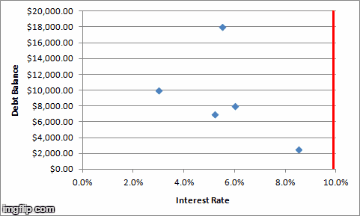In case you hadn't heard, Tax Day was this week. As I was perusing my preferred news outlet, I came across a link to this article. It explains how criminals file tax returns on behalf of others, both living and dead, taking advantage of several flaws in our tax system. A young couple, for example, was supposed to get a $3,500 tax refund this year, but because someone else already filed taxes as the husband, it would be months or years before they see a dime. This couple was going to use the refund to help with the downpayment on a house, but now they're going to have to move in with his mother.
I have two issues with this article:
- While $3,500 is a substantial chunk of change, it should never be the difference between BUYING A HOUSE and MOVING IN WITH MOMMY. In other words, this couple is probably not even close to being ready financially to buy a house.
- Why in the world is your refund $3,500 in the first place?
"Well, even if I put $3,500 in a savings account for a year, I'd still only get like 50 cents in interest. So it's not worth the effort to fix my W-4." If you've ever thought something similar to this, try thinking about it like this: You could give yourself a raise of $300 per month with that $3,500 refund. Now, you can obviously get by without this extra $300 a month, because otherwise you would have fixed your tax withholding long ago, right? But if you paid even a dollar in interest on a credit card, mortgage, car loan, etc., you could've netted way more than 50 cents. Here are a few examples (here's the math behind them):
Example 1Say in January 2014, you had a $2,000 balance on a credit card with 18% interest rate and $50 minimum payment. If you pay the minimum payment until it's paid off, it'll take 5 years and cost ~$1,000 in interest. Maybe you're a little better and only pay the minimum payments until April 2015, when you receive your $3,500 refund and then completely pay it off. In this case, you pay the debt off in 15 months and pay ~$420. If instead of waiting for the refund, you give yourself a $300/month raise and use it to pay off credit card ($350 monthly payments), the debt will be out of your life in 6 months and you'll have limited the paid interest to ~$90. This approach saves you about $330, which, last time I checked, is substantially more than 50 cents!
Example 2If we replace the credit card debt in Example 1 with a student loan of $50,000 at 6% and $500 minimum payment, the same three approaches look like this:This saves you ~$1,400 over 7 years or ~$200 a year. Saving yourself $1,400 seems like a pretty good use of the 30 minutes it would take to fill out your W4 each year. When was the last time you got paid $400/hour?
- Only minimum payments takes almost 11.5 years and costs ~$19,200 in interest
- Minimum payments with a lump sum of $3,500 each April takes just under 7 years and costs ~$11,300 in interest
- Pay $750/month (initial minimum payment + $300 each month) until it's paid off takes just over 6 years and costs ~$9,900 in interest
These examples require that you change NOTHING about your current lifestyle, spending habits, or career path. All you have to do file a single page form with the US Government, and I didn't even take into account state income tax returns. So you should definitely fix your W-4 (talk to your HR person if you don't know how to do it) and get super excited about the higher paychecks you're now getting instead being disappointed that you don't get to wait until April for a lump sum.
Also, in case it wasn't obvious, you should file your taxes as soon as you're able, so criminals don't have the chance to file them for you and cause you a massive headache.
IMPORTANT NOTE: If you're like me, you might be thinking "Can I get a free loan from the government by underpaying my taxes until April?" Answer: No. If you substantially underpay your income taxes, the lovely government will hit you with a penalty on top of the taxes you owed all along. So the goal should be no money due AND no money paid at tax time.
Also, in case it wasn't obvious, you should file your taxes as soon as you're able, so criminals don't have the chance to file them for you and cause you a massive headache.
IMPORTANT NOTE: If you're like me, you might be thinking "Can I get a free loan from the government by underpaying my taxes until April?" Answer: No. If you substantially underpay your income taxes, the lovely government will hit you with a penalty on top of the taxes you owed all along. So the goal should be no money due AND no money paid at tax time.


